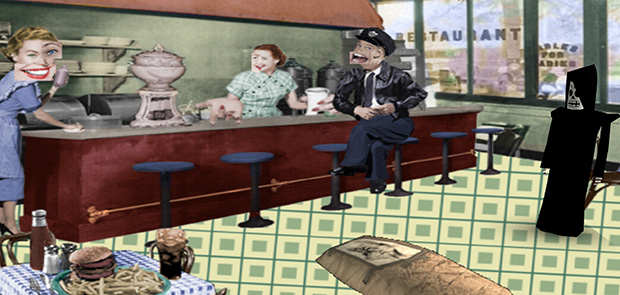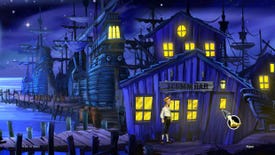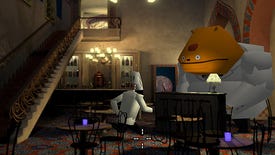Wot I Think: Grim Fandango Remastered
Back to the land of the living
Grim Fandango (official site) is considered the end of Lucasarts' imperial period (no pun intended): its first 3D adventure game, its last to be helmed by Tim Schafer, and arguably the most mature and character-focused offering from the Monkey Island/Day of The Tentacle/Sam & Max studio. Naturally, it was a commercial failure.
17 years later, and everything has changed. This Mexican folklore and film noir-influenced tale of sometime grim reaper Manny Calavera's attempt to reach eternal peace in the Ninth Underworld has become beloved enough that it's been 'remastered' with more modern and bearable graphics, sound and controls (its original 'tank' controls being faintly nightmarish). There have been many fan attempts to enhance this rapidly-ageing game, but Double Fine worked out a deal with Disney and were able to go back to the source. Is this the Number Nine train straight to happiness, or does it reach into our chest, pull out our heart and throw it into the woods?
A disclaimer, in order to demonstrate that there is no chance whatsoever ever that I could be remotely objective about Grim Fandango. Please seek other articles if this nostalgia concerns you.
1999. Singapore airport - the only part of Singapore I've ever seen. I'm returning, alone, from a disastrous two-month trip to Australia in which I ran out of money while attempting to keep pace with my vastly more affluent travelling companions, who I'd also found to be very difficult company. For that reason, I'd turned down a dodgy offer to earn some pocket change by picking rocks out of a farmer's field - the only work available to someone without a visa - and elected to take an earlier flight home, one month in. My flight transferred at Singapore airport, where I had to spend 12 hours waiting for my connection. I was miserable, lonely, shoulders heavy with a sense of failure, the growing certainty that I'd abandoned the holiday of a lifetime rather than suffer a few hard knocks to get it back on track. Life had gone wrong, and it was my fault.
Singapore airport was an amazing construct, almost a small, sci-fi city, at least compared to the pipsqueak terminals of Europe, and while I longed for sleep and escape at least there was no shortage of shops to look at, to cast about in hoping to find something to salve my snowballing existential crisis. In one, a toy shop, I saw Grim Fandango. I was dimly aware of it, and that it came from the company as Sam & Max and Day of the Tentacle, which I remembered fondly, but I had paid little attention to games for my first year of university and knew nothing more than that. I also knew almost nothing of art deco or noir, so Grim Fandango's cover looked like a game from another universe. Sombre, stylised, relatively grown-up, mysterious, dangerous. And I so wanted to go to another universe. Its price just so happened to match the small amount of currency I had left - the equivalent of eight or nine pounds, as I recall. Unable to sleep, books all read, tape player batteries depleted, I pored over the box and its contents for the duration of my flight.
Upon reaching home, some 30 hours later, Grim Fandango was the first thing on my mind. Avoid the mingled concern and scorn of my parents, and the terror of how to resolve my costly overdraft. Flee. Escape. Disappear into whatever that place on that CD was. It did not disappoint. It was funny, it was beautiful, but it was about loss and regret, a quest to leave the mistakes of the past behind and find peace. I have not been back to it since.
Let's start with the technical side of things, given the likely majority of this title's audience are people who already know the game itself well. Grim Fandango Remastered is no remake. It is Grim Fandango, with graphical and interface changes subtle enough that it simply looks and feels to 2015 eyes that they're playing the game they did in 1998. Where they to actually play the game they did in 1998 - and an optional mode allows a simulacrum of this - they would think it unacceptably low-tech and hampered by obtuse controls. (Edit - the original control set is still available if you prefer it). In other words, it's the right level of change.
It significantly softens the blow of 17 years' worth of age, rather than replaces too much wholesale. It looks like Grim Fandango, and feels like Grim Fandango - I don't know about you, but I've repressed the trauma of the original's notorious tank controls so the new point and click option simply feels entirely natural.
The main gain is higher-res models and textures for the 3D characters in the game. This is good, in that Manny, Glottis and co no longer look like fuzzy paint-smears, but bad in that their relatively sharp edges sometimes appear anachronistic with the blurrier 2D backgrounds. In some scenes, it looks like models from a newer game superimposed over an older game's environments, which is essentially what the Remastered edition does. The backdrops have been upscaled to some degree, but clearly there limitations on the source material and only so much the remastering team could do.
Surprisingly often, I found myself switching to old-school mode simply because the characters then seemed to blend in rather than stand out, especially in some of the birds-eye view shots intended to demonstrate vast spaces. It could look like someone who stuck a papercraft figure to my monitor. Only occasionally, though.
The same issue is true of the cutscenes, which while better-animated altogether look worse than the game proper as the models haven't been redone in HD (presumably because they couldn't without entirely re-recording every movie clip). There are even some moments where an item you need to pick up is far too obvious, because it's all gleaming and crisp against this ornate yet muddy 2D background, which somewhat impacts the thrill of the hunt.
Overall, though, the remastering is a successful one. Grim Fandango doesn't look modern, exactly, but higher resolutions, a new lighting and shadowing system and an optional widescreen mode allow the intrinsic beauty of its Art Deco/Mexicana mash-up to shine through and look acceptable on a modern monitor. The shadowing on characters is particularly lovely. At times, it does look like a bodge, but especially in close-ups characters benefit hugely. Compromises or not, the game's certainly far better off for this remastering. To some degree, it looks better at lower resolutions too - the character/background dichotomy was exacerbated by my monitor's native 2560x1440, but dropping to 1080p (while not ideal) helped a little.
There's so much care and detail in Grim Fandango's art and architecture. It's not just a technological leap from the cartoonish adventure games which preceded it, but almost a philosophical one - 'we can build more than just an adventure. We can build a world.' There's so much done to maintain coherence, to suggest that this is a lived-on (ho ho) place. That said, there are some scenes where either technological or budgetary limitations make areas of the world seem perhaps too unlived in, but then again this can be waved away by saying that most locations are just stopping-off points on a voyage through an undesired afterlife. For all the ornate decor, most places in the Eighth Underworld are supposed to feel bleak and empty, right? Well, it's a useful excuse, at any rate.
Meanwhile, the remastered, orchestral score is an unmitigated delight, taking what was already a far more thoughtful, diverse and elaborate soundtrack than earlier adventures and blowing it up into the size it deserved to be. Its mix of Mexican music, jazz and simmering doom is a huge part of Grim Fandango Remastered's atmosphere even if, again, it essentially makes the new version feel like the old version did to younger, lower-standards ears (and speakers) back in '98.
Less positively, as a PC game it's got issues, and I can't say yet how many of these are down the limitations of the original game, to what Double Fine wanted to spend on it, or to simply prioritising console/gamepad. In particular, video options are extremely limited, and primarily relate to turning off the visual enhancements in favour of returning Grim to something like its original state. You can't even select resolution, instead choosing between 'Native', 'Lowest' and 'Low' under 'Resolution Scaling', though native is going to be just fine for most people. The lack of anti-aliasing is a particularly sad one though, as jaggies are exaggerated by that dichotomy between high-res 3D model and low res 2D environment. I'm not usually too much of a tech pedant, but the nature of this game really does exacerbate this particular problem. I didn't have any luck forcing AA on in drivers, though doubtless someone will find a fix shortly after release.
Then there's the controls. Point and click for the most part is the intuitive, reliable interface Grim Fandango was always crying out for, but sometimes Remastered has issues with the mouse. There were occasional conversation options that I couldn't seem to select with the cursor, while some of the menu options - including confirming save and quit - would only accept arrow keys and enter. It's not quite infuriating, but it's certainly on the road to it. Hopefully these are minor issues which can be patched easily, but clearly it's always a shame to see a game born on PC given shorter thrift than the console edition.
I should also mention that Grim Fandango hasn't had any kind of autosave added into the Remastered edition, so do remember to save manually. Unfortunately, there's no quicksave button either. I did suffer one crash at one point, discovering to my horror that I hadn't saved for some two hours, so fair warning and all that. (You can at least blow through most sections pretty quickly if you already know how to solve the puzzles, though having to extinguish three flaming beavers all over again did little for my mood).
For your reference, here's before(ish- this is the 'original' mode in Remastered rather than the original itself):
And after:
Like I say, it's subtle but effective enhancement, for the most part.
OK, that's the dry stuff covered. Let's move onto the game. The Big Fat Question Of Questions: does it still hold up?
Yes, absolutely. There are moments where the humour seems too obvious, there are puzzles which grate, and there aren't too many big belly laughs compared to the earlier Lucasarts games, but without question it still feels like a more mature and thoughtful adventure game than the vast majority. Even though it's about skeletons and hot rod-driving demons.
The world-building, in its combination of early 20th century American architecture and Mexican mythology, remains both inspired and nuanced, with occasional diversions into both the unexpectedly bizarre and the surprisingly dark. It might not find that sweet spot of slick interface and big, punchy humour that Day of The Tentacle and Sam & Max did, but Grim Fandango is far braver than anything else from its stable, and then a great many story'n'puzzle games since. It did and does have a rare focus on character, though I would say that in this regard it doesn't seem quite as intelligent and mature as it did at the time. This is pulp, not literature. It is first-rate pulp, however, and I'm not sure I'd have it any other way, even if I am a tougher audience in 2015 than I was in 1999.
I'm particularly impressed still by how it evolves across its act structure. For instance, the relatively light and constrained first 'year' at Manny's office gives way to the sweeping Casbalanca homage that is Rubacava in its second year (very much the game's highlight), replete with a more sombre tone and sense of character growth. Huge amounts of in-game time passes, and this affords Grim Fandango the opportunity to switch things up, meet a new cast and give its protagonist big objectives to strive for, rather than just stumble through various tomfoolery until a conclusion hits. The game changes both setting and theme repeatedly, but without losing sight of its own tone: it builds a consistent and appealing world out of far-flung parts.
Sometimes the visual age of the environment sells the game short, sometimes an excessively patience-testing puzzle does (e.g. the magnetic sign post, the cat racing), sometimes there's too much backtracking, and there are those technical shortcomings on PC, but all told Grim Fandango still hangs together beautifully without quite feeling like a relic of bygone era. Whereas most 90s adventure games simply inspired more cartoon slapstick (in most cases with diminished returns), there's a clear line from this to Kentucky Route Zero, which picked up Grim's bold baton of introspection, architecture and cultural homage and ran a minimalistic mile with it.
Grim Fandango, in other words, still seems like a game from another universe, albeit now one which seems closer to ours than it did at the time. The Remastered edition might not be quite as modernised as we'd hoped, and it's sorely in need of a little more PC-specific TLC, but it is such a pleasure to have it back, so much happier on a modern monitor and good speakers than the original edition, and with non-crazy controls too.
Grim Fandango Remastered is out now.





















